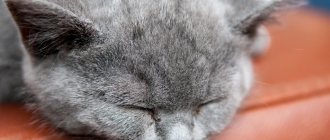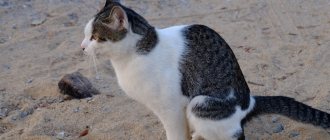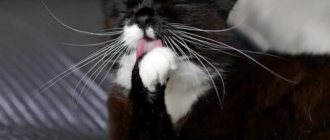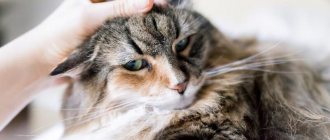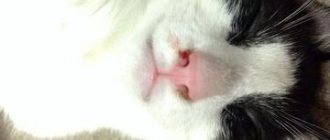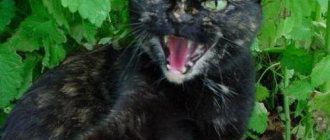Why do they appear?
In a cat, black spots and dots in the mouth arise due to the maximum activity of the cells that are responsible for the release of pigment. Cats are prone to pigmentation, especially red cats. A kitten may be born with black dots and spots on the tongue and palate, and then pigmentation appears on the lip, nose or in the mouth, but this is not dangerous. A genetic predisposition to staining with spots may cause them to appear. If a cat develops black spots at an older age, especially an older one, this requires consultation with a veterinarian. There are a number of factors influencing the appearance of blackheads in the mouth, namely:
- hormonal imbalance;
- poor nutrition;
- problems of the gastrointestinal tract and central nervous system;
- poor immunity.
Sometimes dark spots in the mouth disappear after eating. In such cases, you need to monitor your pet. Cats' tongues are covered with hardened nipples that help them drink, hold food, and lick fur. Perhaps the animal is gnawing on some objects, and the remains get stuck on its tongue, causing it to turn black. When eating food, the cat swallows everything along with it. In this case, there is no reason to worry.
Acne in cats
One of the most likely causes of blackness at the corners of a cat's lips is acne. It appears as a dense dark rash or small pinkish inflamed nodules on the lower lip and chin. Specific symptoms:
- dark spots of comedones;
- inflammation of the mucous membrane of the lower lip (rarely observed);
- swelling and inflammation of the rash on the chin;
- formation of crusts around the mouth.
Acne appears sporadically, but can also be a chronic disease. The disease most often develops due to metabolic disorders, decreased immunity or insufficient hygiene of the pet.
In rare cases, inflammation of the hair follicles may be the result of an allergic reaction to food or the material of the dishes from which the cat eats. In this case, black dots and a pink dense rash appear in places that come into contact with the irritant. If the allergy is triggered by new dishes, a rash will appear on the lower lip and chin.
Associated signs of disease and treatment
Dark spots
In this condition, the animal spends a lot of time sleeping.
Pellagra, or simply hypovitaminosis, affects cats very rarely. Poor or unbalanced nutrition leads to problems in the animal's body. Drowsiness, apathy, as well as the presence of dark spots on the tongue are reasons to contact a veterinary clinic. If the diagnosis is correct, then treatment will be focused on replenishing the pet’s nicotinic acid. Depending on the way you eat, you need to add to your diet:
- vitamin supplements for cats;
- kidneys, liver and fish;
- dairy products and carrots.
Lentigo is a hereditary disease characterized by a brown spot in adult animals. In cats, this condition is quite rare; spots are formed due to an increase in the number of melanocytes on the surface of the skin. Often, a smooth brown rash with a diameter of up to 10 mm is located on the mucous membrane of the mouth and can cover the palate, nose, eyelids and ears. Formation begins in kittens before 12 months and localization expands with age. The disease has no symptoms and does not require treatment.
Black dots
Owners often find such skin rashes on their pets.
Acne is a dark rash on the skin in the form of blackheads. Having tried to erase blackheads and failed, the owner is convinced that the cat has acne. Concomitant signs of skin diseases may include swelling, baldness and redness of the skin, and the number and volume of acne increases. The pet's behavior is restless and it scratches the itchy area. Since the disease is a concern, you should consult a veterinarian and undergo an examination. In animals, as in people, acne on the skin can be a consequence of blockage of the sebaceous glands, and then treatment can be carried out with folk remedies, rubbing the sore spot with herbal infusions.
Melanoma is the presence of malignant tumors in the body. The appearance of black spots or spots on the gums in an elderly pet, as well as apathy and loss of appetite should alert the owner. Since the presence of a tumor can only be determined by a doctor, and treatment requires surgery, you should urgently contact a veterinary clinic for examination.
If there is a putrid smell from the mouth, then the cat may have a serious disease of the teeth or gums.
What is feline lentigo
Feline lentigo is a harmless skin condition that causes small black spots to appear on the skin, gums, and even around the eyes and nose. These black patches, also called lentigo simplex, are not a cause for concern if they are flat and have the same texture as the surrounding skin.
Think of these spots as the cat's equivalent of freckles. Your cat will likely develop a few more spots over time, and sometimes the spots may appear suddenly. Some cats will have many lentigo spots, while others will have just one or two.
Unlike freckles, sun exposure is not a direct factor. Your cat is most likely just predisposed to these small spots; it has nothing to do with your care or your cat's environment.
How to warn?
Cats are quite clean animals, so rashes on the lips, apart from hereditary ones, are quite rare. A poorly balanced diet and the inability of a cat to replenish its diet with the vitamins and minerals it needs leads to an imbalance of the entire body. The owner needs to monitor the animal’s food and wash the food bowl on time, since bacteria multiply well in dirty dishes, which can get into the mouth while eating. Air pollution and frequent psychological stress from aggressive behavior with the pet by its owner can also cause the appearance of spots and spots. Only the care and quick reaction of the owner to any changes in the behavior or appearance of the pet will give it a long and happy life.
Final thoughts
Changing skin and coat color over time is a normal part of your cat's life. But any sudden change in your cat's coloration can be a cause for concern, especially if it is accompanied by other symptoms at the same time.
Lentigo is not the only skin pigmentation condition in cats. Cats can also get vitiligo, which is almost the opposite of lentigo. Vitiligo causes a lack of melanin in areas of the skin, and in cats, vitiligo can also affect coat color. Typically, vitiligo spreads gradually over time, causing your cat's skin and fur to turn white.
On the other hand, lentigo is usually limited to the skin, meaning that you may only see lentigo in areas where your cat's skin is visible.
Reasons for appearance
Gangrenous stomatitis in a kitten or cat can develop against the background of any other diseases, weak immunity, various injuries to the oral cavity (prick with a bone, branch, thorn of a plant). The following may also be the cause:
— chemical burns (swallowed alkaline solutions, salts of heavy metals, etc.);
— thermal burns (too hot food or inhalation of steam);
— fungal diseases (candidiasis);
- diseases of the teeth and gums (gingivitis, caries, periodontal disease);
- diabetes mellitus and other difficulties with the endocrine system;
— autoimmune diseases;
— infectious (calcivirosis, rhinotracheitis, papillomatosis, etc.);
- lack of vitamins (as a rule, stomatitis can be caused by a lack of A, B, C, E and PP);
- oncology, especially in the neck and head area.
Caries
The process of demineralization, accompanied by the destruction of the hard shell of the tooth and the formation of a cavity in its tissues, is called caries.
Caries occurs in several forms, which characterize the depth of damage to hard tissues:
- stage of a light spot (reverse development of the pathological process is possible for unknown reasons) - there are no changes in the structure of the tooth;
- superficial carious process - a dark pigment spot appears on the enamel, the enamel softens;
- with average carious lesions, enamel and dentin suffer;
- deep damage leads to complete damage to the tooth, affecting all its tissues, and attacks of acute pain are possible if hot or cold food comes into contact with the tooth; after the cessation of exposure to the temperature factor, the pain stops.
In the acute course of the pathological process, several teeth may be affected. In this case, the affected areas look like dirty gray spots.
Symptoms:
- decreased pet appetite;
- changes in the cat’s eating behavior (the animal may chew on one side or try to swallow food with minimal chewing movements);
- foul odor from the mouth;
- hypersalivation;
- change in color of the affected tooth;
- pain when chewing.
The cat cannot complain of pain, but will avoid any touching of the sore tooth.
Treatment:
1. At the initial stage, the veterinarian can use local antiseptics:
- silver nitrate;
- sodium fluoride.
2. If the damage is serious, the tooth is removed.
General prevention
Attention to the cat’s oral cavity is the main rule for preventing inflammation.
Since the main causes of both diseases are common, preventive measures will be common for both diseases.
The first and inviolable rule of prevention is special attention to pets.
It is necessary to carefully monitor the condition of the cat's oral cavity.
, clean regularly, approximately once or twice a week. The cat's diet must be balanced with the necessary vitamin and mineral supplements. Do not feed only soft food.
It is recommended that your pet consume ready-made food designed specifically for cleaning teeth and preventing the formation of tartar. If this has already happened, do not delay visiting a doctor. Otherwise, the complication is fraught with the loss of the entire jaw, which for a predator is tantamount to death.
Cats always give the impression of being extremely clean animals, as they lick their entire body for a long time to maintain hygiene. They do this not so much to remove dirt as to neutralize a specific odor. Since the cat’s tongue is always visible, it is not surprising that with its pathologies, the owner quickly notices signs that something is wrong. In particular, you should be wary if you notice a white tongue on a cat.
Your kitty's tongue is a multi-functional tool.
It is used for food and drink, performing the function of a kind of “spoon”; with its help, the animal keeps its fur and skin in order. Thus, with any more or less serious diseases of this organ, the animal will have serious problems. It will not be able to take care of itself, and the process of eating food will become noticeably more difficult. So what diseases, in principle, can directly contribute to a change in the color of the tongue?
Any inflammatory pathology of the oral cavity can lead to such consequences. The simplest and most common option is stomatitis.
, also known as inflammation of the tissues of the oral cavity. is common and quite likely
(this term refers to inflammation of the tongue itself).
It is possible that the whitish coating on the surface of the organ appeared as a result
(that is, of the same inflammation, but of the gums).
White tongue
– a rather characteristic, specific symptom indicating the initial stages of tartar formation
. If at this moment you start treating your teeth and tongue with a weak water-salt solution, or a solution of baking soda, serious consequences can be avoided. In addition, a white tongue (more precisely, the root of the tongue) is a fairly common sign of acute (inflammation of the gastric mucosa). With chronic inflammation, the tongue also turns white, but more often this can be noticed only during the period of exacerbation of the disease.
Gingivitis
Gingivitis is an inflammation of the gums in a cat; in the initial stages it occurs as a mild disease. But if you start the process, then not only the superficial layers of gum tissue are affected, but also the deeper ones. Inflammation affects the ligaments that hold the animal’s teeth in the socket, causing them to fall out.
Symptoms:
- Excessive salivation is the very first characteristic sign of the disease; drool is usually viscous and hangs in the form of “icicles”. It is easy to detect in the initial stages of gingivitis in cats and begin treatment on time.
- Swelling – puffiness is a fairly noticeable symptom; the gums begin to “hang” over the teeth.
- Redness – the gums may also have whitish spots or be bluish in color. Upon examination, there will be a bright red stripe on the gums near the base of the teeth. Normally, cats have pale pink oral mucosa.
- Bleeding can be independent and constant, or detected by pressure.
- Strong unpleasant odor from the mouth.
- Severe pain - the cat reacts aggressively to an attempt to examine the mouth, begins to refuse food, and loses weight.
- With ulcerative gingivitis, characteristic ulcers appear on the gums; due to pain, the cat may refuse not only food, but also water.
Treatment:
1. Remove tartar and brush your teeth regularly.
2. Treat the oral cavity with herbal decoctions (oak bark, chamomile) or antiseptic solutions (miramestine, chlorhexidine).
3. Lubricate the gums with dental ointments (Zubastic or Dentavedin).
4. In case of severe inflammation, the veterinarian can prescribe the cat the antimicrobial and antiseptic agent Metrogyl Denta (active ingredients metronidazole benzoate and chlorhexidine gluconate). 5. To speed up the healing of gums, use oil solutions of vitamins A and E, rosehip or sea buckthorn oils, ointments with actovegin or solcoseryl (these substances activate tissue regeneration processes).
Tartar
In fact, tartar is the same plaque, which is a colony of microorganisms that has only undergone calcification. It is quite strong and hard, has a brownish tint and is capable of growing.
Symptoms:
- Finding dark yellow or brown growths on your cat's teeth.
- The appearance of bad breath.
- Bleeding and inflammation of the gums.
- Soreness may appear, the cat may begin to eat poorly, or even lose its appetite.
Treatment:
1. Grinding of teeth with a special paste. Used at the initial stage of the disease.
2. Tartar removal: mechanical or ultrasonic.
Spots on the lips of ginger cats
Approximately 60-70% of Russians live at home with a purr. We perceive pets as family members and take care of them no less than we would a child. In addition, the Red Cat is a real healer! Read: Features of red-colored cats.
Naturally, when we see brown spots on our beloved furry that were not there before, we involuntarily tense up and ask ourselves the question - what if this is something dangerous? We involuntarily go on the Internet, see scary pictures, nervously read sites with terrible diagnoses and look at our pet. But before you panic, you should figure out what it really is.
Periodontal disease
Symptoms:
- Bad breath. One of the main reasons for visiting a veterinarian. The smell from the mouth becomes unbearable, putrid in nature, and can be felt from afar (when the animal enters the room).
- Decreased appetite. The cat wants to eat, but cannot. Refuses the once-favorite “crackers”, preferring soft food.
- Strange behavior. Owners notice how the pet shakes its head, rubs its muzzle with its paw, as if trying to get something out of its mouth. Sometimes you can clearly hear teeth grinding. The cat slurps when chewing. After eating, the lower jaw may tremble.
- Constant discharge from the mouth. A sick animal will drool profusely. Blood or pus may occasionally leak from the mouth. The fur on the chin is wet all the time, the skin becomes inflamed.
- Tartar and gum inflammation. If the cat is calm, you can move the upper lip and look into the mouth without opening its mouth. It is easy to notice yellow-brown tartar - massive hard deposits that sometimes completely cover the tooth itself. The gums are bright red or bluish in color and bleed. When pressed, a pus-like gray mass may come out from under it.
1. Hygienic cleaning of teeth from plaque and tartar at the initial stage of the disease. After this procedure, the crowns are coated with a fluoride-containing protective varnish. I treat the gums with antiseptic solutions and dental ointments (for example, Metrogil Denta).
2. Surgical intervention.

